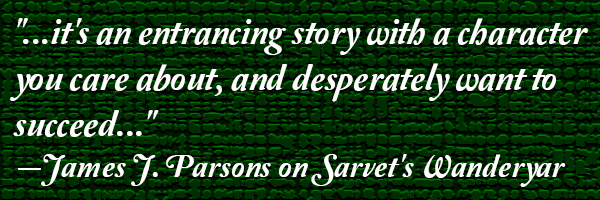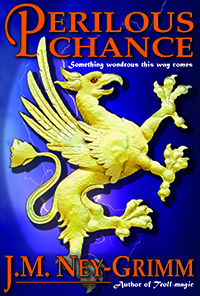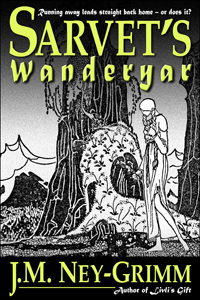Goodreads is essentially a social media website for readers. Its stated mission? “To help people find and share books they love.” This April, Goodreads announced that 50 million reviews of books had been posted by users on the site. There’s no doubt that many, many readers frequent Goodreads and that many authors hope to catch the attention of some of those readers.
One of the aids to discoverability offered by Goodreads is its giveaway program.
The author or editor or publisher of a book lists the title in the GR giveaway program, specifying the dates during which the book will be offered, the number of copies to be given away, and which nationalities are eligible to participate. Goodreads chooses the winners. Then the author (or editor or publisher) mails the paperback books.
I first tried the program in 2013 with my novel Troll-magic.
I followed the GR recommendation that I give away 10 copies and that I let the giveaway run for a month, from March 1 to April 1 in this instance. I limited the countries to the US, the UK, and Canada, because I was concerned about shipping costs.
As it turned out, US shipping averaged $4 per book, the UK $5 per book, and Canada $7 per book. I sent each copy directly from CreateSpace. International shipping from the US has become more expensive now than it was back in 2013, so how you get the books to the giveaway winners is even more important. I suspect CreateSpace mails each book from the plant nearest to the specified address and thus gets the cheapest shipping rate possible.
Just last month, when I attempted to mail a brand new copy of Quantum Zoo sitting on my shelf at home to a reader in the UK, I was shocked to learn it would cost me $24 or more! I quickly reverted to sending the book directly from CreateSpace.
 So how did my first giveaway turn out?
So how did my first giveaway turn out?
Troll-magic
March 1 – April 1, 2013
Sign-ups: 580
# put on GR to-read list: 239
Reviews: 2
Money spent: ~$112
I wasn’t impressed.
At the time, Troll-magic had been out for 14 months. When it first released, about ten of my family and friends bought and read it. After that it sold one or two copies a month. It seemed fairly clear that the book was largely invisible, readers who might like it stumbling upon it by sheer chance.
What I wanted to do was advertise Troll-magic in one of the newsletters then available, such as Pixel of Ink or Ereader News Today. But in order to be accepted by such advertisers, my book needed reviews. Most readers do not write reviews. I’ve heard rates ranging from one reader out of a hundred to one reader out of a thousand who will do so. But no matter where the truth might lie, my book was not selling enough copies to garner reviews.
The Goodreads giveaway guidelines state that the average giveaway book receives six reviews for every ten copies given away. They caution that this is an average. Each title will perform differently.
Troll-magic received only two, and their substance was not in the least helpful. One winner’s review was merely a note explaining that she was too busy to read at that moment, but that she planned to bring Troll-magic on her next vacation and maybe read it then. The other winner said that Troll-magic had too many point-of-view characters for her taste. (It has five.)
I did notice that the book sold 5 copies in April, instead of its usual 1 or 2. But I was not convinced the increase was due to the giveaway. I’d tinkered with the book’s keywords. The increase could well be due to that change. I’d also joined a writers’ group that focused on marketing. There were five of us in the group, and the other members were reading Troll-magic in April. I figured 4 of the 5 sales were my fellow writers buying their copy to read.
However, the GR guidelines were talking about averages. With reason. The tire is always going to meet the road in the specific readers who win. And the readers who enter a giveaway will not be as choosy as they might be, if they were spending their own money to buy a book. Some of the readers signing up would be people whose reading tastes are such that they will never like any of my work. Some of the winners could be readers who will never like my work. If I’m really unlucky, all of the winners might be such people!
I decided I would try another giveaway with a different book.
 Sarvet’s Wanderyar
Sarvet’s Wanderyar
August 31 – September 30, 2013
Sign-ups: 384
TBR list: 149
Reviews: 6
Money spent: ~$70
These were better results! Six reviews, and all of them positive: one 3-star rating (I liked it!) and five 4-star ratings (I liked it a lot!).
The substance was better too.
“I loved this book and recommend it to everyone…” a cup of coffee and a fairytale • “Short and sweet and easy to read.” Nadhirrah • “I enjoyed the author’s style, and how she successfully wove together a brief story that did not sacrifice depth and detail.” Tyler • “Wonderful tale of coming to age…” Jay • “…quite engaging. Sarvet’s Wanderyar is a bildungsroman that depicts a girl’s transformation from an innocent and fearful child to a wide-eyed and open woman.” Shelby Rollenhagen
I’m not sure I noticed that in the month following the giveaway, Sarvet’s Wanderyar sold 5 copies instead of its usual 1 or 2. Since I spent $70 to purchase and mail 10 copies to giveaway winners, and those 5 copies sold (at $2.99 each, with Amazon keeping its 30%) netted me only $10.46, the giveaway was not a cost-effective way to advertise. But I note the increase now. At the time, I remained focused on gathering honest reviews.
Because the results of the Sarvet and the Troll-magic giveaways were so different, it seemed clear that one could not depend on any one giveaway. The sensible thing to do would be running a series of them. I decided to run giveaways for each of the novels and novellas that I had published.
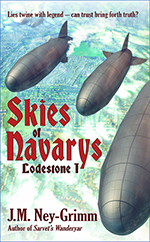
Skies of Navarys
November 25 – December 20, 2013
Sign-ups: 509
TBR list: 187
Reviews: 2
Money spent: ~$70
2014 sales rate: ~1 per month
JAN sales: 0
“The characters are realistic thirteen years old with all their curiosity, doubts, amiability and daring in the face of adversity.” Wendy • “The plot of this novel was more action driven than character driven.” Lyle Appleyard (Note the opposite reader reactions!)

The Troll’s Belt
January 13 – February 8, 2014
Sign-ups: 597
TBR list: 207
Reviews: 6
Money spent: ~$70
2014 sales rate: ~1 every 2 months
FEB sales: 3
“Different take on an old classic. Enjoyed thoroughly.” Shelia • “Wow… It was a really good read.” Emilia • “There were a lot of loose ends left.” Bob Stuhlsatz • “The part of the story I enjoyed the most was…about finding courage to get yourself out of a situation that seems hopeless.” Deanna Lenz • “…a good book that I’ll be holding on to to read to/give to my son when he’s older.” Bel
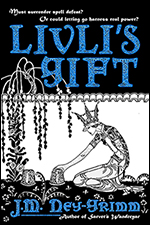
Livli’s Gift
February 17 – March 22, 2014
Sign-ups: 848
TBR list: 332
Reviews: 4
Money spent: ~$90
2014 sales rate: ~3 every 2 months
APR sales: 3
“…the novel was beautifully written.” Eva • “It was truly a trip reading Livil’s Gift. Especially when the character goes into trance…” Jay • “…a good story.” Sabrina Bradley • “I cannot believe how lucky I am to have received this incredible treasure of a novel for free…” Joe
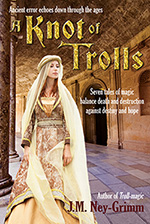
A Knot of Trolls (anthology)
April 14 – May 10, 2014
Sign-ups: 789
TBR list: 295
Reviews: 1
Money spent: ~$95
2014 sales rate: ~1 per month
MAY sales: 2
“I don’t read a ton of high fantasy so I was a little apprehensive to start reading this book. However, I found these stories to be a fun and interesting read. Ney-Grimm has created a fascinating new world rich with details and memorable characters. Very well written, Ney-Grimm paints a vivid world full of magic.” Alisha
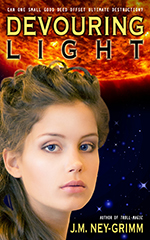 Devouring Light
Devouring Light
June 30 – July 26, 2014
Sign-ups: 599
TBR list: 238
Reviews: 1
Money spent: ~$85
2014 sales rate: ~3 every 4 months
AUG sales: 2
“Pretty accurate understanding of astrology… Hades: I have a real problem with people always portraying him in an ‘evil’ light; as far as gods go he was actually pretty nice.” Jodi
(Okay… the reader is always right about her experience. Yes. But this is my blog, so… my novella Devouring Light has nothing to do with astrology; it is inspired by mythology and the ancient Greek cosmological model of the celestial spheres. I portray Hades as a complex character, not an evil one. Just sayin’.) 😀
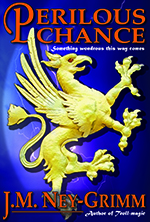
Perilous Chance
August 18 – September 19, 2014
Sign-ups: 859
TBR list: 351
Reviews: 2
Money spent: ~$75
2014 sales rate: ~3 every 2 months
SEPT sales: 4
“…lovely fantasies …quite enjoyable …great characters… Thank you.” Vykki • “It was almost poetry-like. That threw me off a little bit and caused me to not enjoy it that much.” Tyler Knight (Ah. Not fond of lyrical prose!) 😉
At this point I’d run 8 giveaways, spent ~$665, and had seen only 1 or 2 reviews for the last 4 giveaways. It was time to assess my overall results.
My first thought? Goodreads giveaways are awfully expensive for the results they generate! I can’t afford to carry on in this way!
Looking at the average numbers… $84 spent per giveaway, 645 sign-ups per, 250 TBR, 3 reviews generated per, I decided I was done with giveaways.
There the matter lay for nearly a year and a half. “But, but, but…” as Ian Fleming writes in the delightful book (not movie) Chitty-Chitty-Bang-Bang.

I had 8 lovely, brand new copies of Quantum Zoo sitting on my bookshelves, because I’d wanted to see a pile of them all in one place and I’d been convinced I would give many copies as gifts the previous Christmas. (I gave two of the ten I’d ordered. Ha!) 😀
And then I heard several indie authors say that the optimum number of copies for a GR giveaway was one or two, not ten.
What if I tried a 2-copy giveaway for Quantum Zoo? I’d already paid for the books. Even if both winners lived in Canada, I’d need to spend only $14 to learn how a 2-copy giveaway performed.
I set it up. And then, in a burst of enthusiasm, I set up 2-copy giveaways for Hunting Wild and Caught in Amber as well.
So, how did they go?
First, let me say that I was ill-informed about international postal rates here in the US. The last time I’d mailed a gift to a friend who lived across the Atlantic, the shipping rates were reasonable. Apparently that changed sometime in 2015. As it chanced, one QZ winner lived in Canada, the other in Britain. I would need to spend $24 each in order to get the books to the winners, for a total of nearly $50. No way! I quickly reverted to my old standby of sending them direct from CreateSpace, but it meant I spent ~$24 (for books and postage) instead of the $14 I’d estimated.
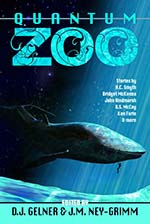 But what about sign-ups and TBR lists and sales?
But what about sign-ups and TBR lists and sales?
Quantum Zoo
May 18 – June 17, 2016
Sign-ups: 1205
TBR list: 294 +292 = 586
Reviews: 1
Money spent: ~$24
2016 average sales rank: ~#300,000
JUNE sales rank: #112,624
“5 stars… an interesting collection of stories… through the weird and the wonderful…” Michael
(Quantum Zoo is on my fellow editor’s KDP desktop, not mine, so I don’t have immediate access to sales figures.)

Hunting Wild
May 17 – June 17, 2016
Sign-ups: 811
TBR list: 315
Reviews: 0
Money spent: $15.47
2016 sales rate: 1 per month
JUNE sales: 1
“This is really well done. I only meant to read a few pages, and looked up a couple hours later when I finished.” Amazon review
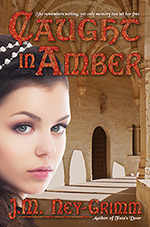 Caught in Amber
Caught in Amber
May 12 – June 17, 2016
Sign-ups: 1069
TBR list: 428
Reviews: 0 (one 4-star rating)
Money spent: $20.71
2016 sales rate: 3 per month
JUNE sales: 3
“The writer gave herself a difficult challenge with the setup, as for most of the book there is just one character, trying to survive and figure things out. It works. The writing is atmospheric and lyrical…” Amazon review
Obviously the proponents of the 2-copy (or less) giveaway were correct in asserting that it made no difference to the number of sign-ups. The most I’d ever received for a 10-copy giveaway was ~800. Yet both Quantum Zoo and Caught in Amber broke the 1000 mark. Hunting Wild is a novella. It received 811 sign-ups, compared to the ~500 that my other novellas received.
Nor did the fewer copies offered seem to negatively affect the number added to TBR lists, each in the 300 – 400 range.
For making readers aware that a book exists, 2-copy giveaways seem just as effective as 10-copy giveaways.
What about reviews?
Honestly, I’m no longer pursuing reviews. Sure I like receiving them, especially the glowing ones! If a reader were to ask me my preference, I’d say, “Please! Do leave a review! Yes!” But I’ve had the chance to try some of those newsletter ads that have review thresholds, and none were effective.
Most require that the book advertised be on sale for 99¢, which means I’ll make 35¢ for each sale. The ads cost between $15 and $40 (or more). So I’d have to sell from 43 to 115 copies in order to break even. I don’t. So far, the best a newsletter ad has done for me is 8 copies sold – nowhere near good enough.
I’ve come to the conclusion that most of my audience are not finding their next good book from such places. I’m not myself.
Oh, I tried the newsletters as a reader for several months. And I regretted buying (and reading) the few books that caught my attention. Maybe that makes me a cranky old cow, but I don’t think so. I suspect that not many writers are writing the type of book I enjoy, and those that are do not advertise on Ereader News Today, etc.
Furthermore, I’m guessing that readers of J.M. Ney-Grimm books are also not able to find a lot in the newsletters that appeal to them.
Now that I have the ability to buy spots in the newsletters, I’m no longer very interested in doing so. Wouldn’t you know! 😀
However, I’m reconsidering the proper purpose of GR giveaways and whether they might be useful for overall discoverability. As I prepared to write this post, I did a little digging online (again) for what other authors had to say about giveaways, and I found a very interesting post by Catherine Ryan Howard. She agrees with two of the conclusions I’ve come to: 1) don’t use GR giveaways to get reviews, and 2) don’t give away 10 copies at a time.
I wish I’d encountered her advice before I did all my expensive experimenting! Although she wrote it just as I was starting my last 10-copy giveaway, so… too little, too late? 😀
But I’m wondering if a 1-copy giveaway might have a place in my launch strategy for new books. Reviewing the effect that giveaways had on my sales, looking at the long term, not the short term, was very interesting.
Up until May 2013, I sold very few books. With each new release, the four friends who’d decided they actually enjoyed reading my fiction would make their purchases. Another handful of strangers would buy their copies. And then the book would settle down to selling very sporadically.
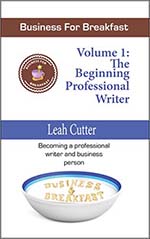 I was in what Leah Cutter, author of Business for Breakfast, calls the “drips stage.”
I was in what Leah Cutter, author of Business for Breakfast, calls the “drips stage.”
You write a novel and publish it.
Somebody buys it. Great! This is a drip. You make another sale that month. Maybe you don’t sell anything the following month. Then you have another sale. … A sale here, a sale there.
She described my experience well.
But in May 2013, something changed for me. I reached what Cutter labels the “trickle stage.” (Cutter calls books “properties” in the quote below, as in “intellectual properties.”)
Everyone who has read your stuff loves it. You continue to write and publish. But your work hasn’t found its audience yet. Drips continue. Then, at some point… you notice a change. A single property may still only have a sale every other month or so. However, this other property is also selling a copy every other month. … Not a single property is selling consistently or well. However, all your properties sell one or two here or there. Suddenly you have a trickle.
That was it exactly.
From the time my first book released in December 2011 through April 2013, I sold in drips. Most months I sold 1 copy of one of my titles. Some months I sold 4 or even 8 copies. Some I sold 0. Once I sold 14 copies! That was exciting! But I never knew what to expect. I hated the “drip stage”!
I won’t claim that “everyone” who read my work loved it; the reviews that appeared were by-and-large positive and one reader who kept a blog posted several glowing reviews on his site. I was encouraged, but eager to reach more readers.
Then, in May 2013, I sold 20 books. From that month onward, my sales stabilized. I averaged 12 sales per month, with a low of 6 and and a high of 33, most often hitting the 9 – 15 range. I had reached Cutter’s trickles stage. And – looking back – I suspect it may have been the Goodreads giveaways that did it.
It couldn’t have been the writers’ group I joined (as I surmised in the immediate wake of the Troll-magic giveaway). There were only five of us, and when the other members read Troll-magic for the purpose of giving me marketing suggestions, only two of them purchased the book. The other two sideloaded it to their ereaders from a file I emailed to them. And after they’d read it, three of the four said, “I don’t usually read this type of fiction, but I liked it anyway.” I seriously doubt they converted to Ney-Grimm fandom. 😀
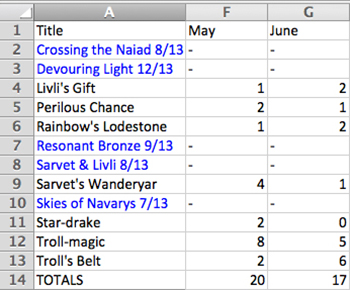 So, where did the sudden and sustained increase in sales come from?
So, where did the sudden and sustained increase in sales come from?
It could have been the keyword changes I made, but I doubt it. Their main use is to determine which categories Amazon places your book in, and which “bestseller” list it will appear on when sufficient copies are sold.
Some writers get a lot of sales when their book appears on a bestseller list, due to the increased visibility. My sales have always worked exactly opposite to this. Some unknown factor will prompt a spurt of sales and pop Troll-magic onto the Norse bestseller list. But once the book is there, the extra visibility does not result in more sales. Instead, the book slowly slides down the rankings and eventually off the list. Until the next time a spurt of sales pops it back onto the list.
That behavior fits with what I suspect about my audience. They don’t get their reading recs from bestseller lists, any more than they do from newsletters.
Which means… that the greater visibility for my books that suddenly arrived May 2013 was caused either by the Goodreads giveaways or by some other unknown factor. There’s no way to know for sure, of course.
But my next step will be trying a 1-copy giveaway. Will it receive as many sign-ups as a 2-copy giveaway? What about additions to TBR lists?
I currently average 20 books sold per month. Would a series of 1-copy giveaways with short, 7-day durations as recommended by Catherine Ryan Howard boost my visibility to the next level (Leah Cutter’s “streams”) the way the first giveaways boosted me from “drips” to “trickles”?
I still have more questions than answers, but I’ve got some new questions. 😀



